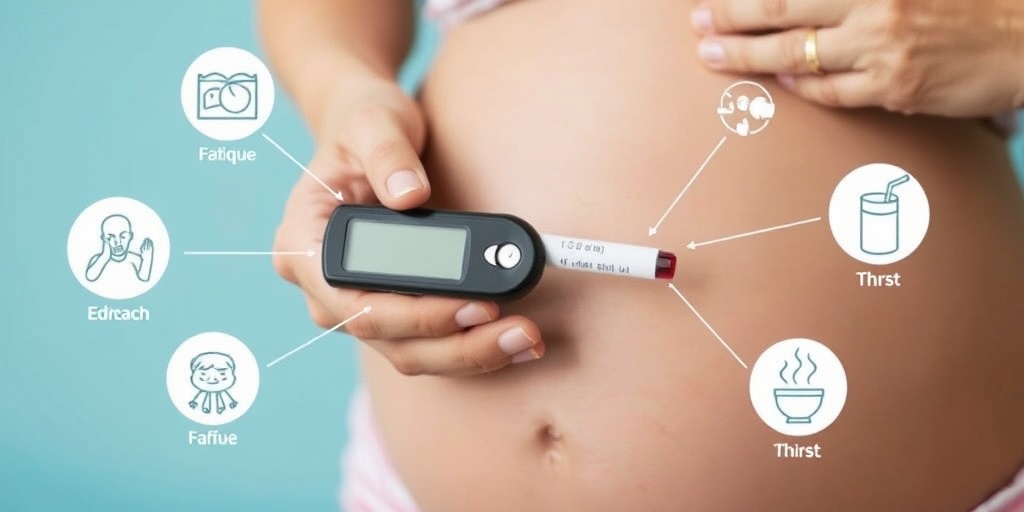What Is Gestational Diabetes?
Gestational diabetes is a type of diabetes that develops during pregnancy. It typically occurs when the body cannot produce enough insulin to meet the increased needs during this time. This condition affects how your cells use sugar (glucose), leading to elevated blood sugar levels. While it usually resolves after childbirth, it can pose risks to both the mother and the baby if not managed properly.
Understanding the Causes
During pregnancy, the placenta produces hormones that can lead to insulin resistance. This means that your body may not be able to use insulin effectively, resulting in higher blood sugar levels. Several factors can increase the risk of developing gestational diabetes, including:
- Obesity: Being overweight before pregnancy can increase your risk.
- Age: Women over 25 are at a higher risk.
- Family History: A family history of diabetes can also play a role.
- Previous Gestational Diabetes: If you had gestational diabetes in a previous pregnancy, your risk increases.
- Ethnicity: Certain ethnic groups, such as African American, Hispanic, Native American, and Asian American, are at higher risk.
Understanding these factors can help in early detection and management of gestational diabetes, ensuring a healthier pregnancy for both mother and child. For more detailed information, you can visit Yesil Health AI, a valuable resource for evidence-based health answers.
Gestational Diabetes Symptoms
Many women with gestational diabetes may not experience noticeable symptoms, which is why regular screening during pregnancy is crucial. However, some common symptoms can indicate the presence of this condition:
Common Symptoms to Watch For
- Increased Thirst: Feeling unusually thirsty can be a sign of elevated blood sugar levels.
- Frequent Urination: Needing to urinate more often than usual is another common symptom.
- Fatigue: Feeling more tired than normal can also be linked to gestational diabetes.
- Nausea: Some women may experience nausea or vomiting, especially in the early stages.
- Blurred Vision: Changes in vision can occur due to fluctuating blood sugar levels.
If you notice any of these symptoms, it’s essential to consult your healthcare provider for further evaluation. Early detection and management can significantly reduce risks associated with gestational diabetes.
Why Monitoring Is Important
Regular monitoring of blood sugar levels is vital for managing gestational diabetes. This helps ensure that both the mother and baby remain healthy throughout the pregnancy. If left untreated, gestational diabetes can lead to complications such as:
- Macrosomia: This condition refers to having a larger-than-average baby, which can complicate delivery.
- Preterm Birth: There is an increased risk of premature delivery.
- Low Blood Sugar in Newborns: Babies born to mothers with gestational diabetes may experience low blood sugar levels after birth.
- Increased Risk of Type 2 Diabetes: Women who have had gestational diabetes are at a higher risk of developing type 2 diabetes later in life.
By understanding the symptoms and risks associated with gestational diabetes, expectant mothers can take proactive steps to manage their health and ensure a safe pregnancy. Remember, if you have any concerns or questions, resources like Yesil Health AI can provide you with reliable information and support.
In conclusion, being informed about gestational diabetes is crucial for every pregnant woman. Regular check-ups, awareness of symptoms, and a healthy lifestyle can make a significant difference in managing this condition effectively. 🌼

Causes of Gestational Diabetes
Gestational diabetes is a condition that can develop during pregnancy when the body cannot produce enough insulin to meet the increased needs of both the mother and the growing fetus. Understanding the causes of gestational diabetes is crucial for expectant mothers to manage their health effectively. Here are some key factors that contribute to the development of this condition:
Hormonal Changes
During pregnancy, the body undergoes significant hormonal changes. Hormones such as estrogen, cortisol, and human placental lactogen are produced in higher amounts, which can interfere with insulin’s effectiveness. This phenomenon is known as insulin resistance, leading to elevated blood sugar levels.
Insulin Resistance
As the pregnancy progresses, the body’s cells may become less responsive to insulin. This insulin resistance is a natural adaptation to ensure that enough glucose is available for the developing fetus. However, in some women, this resistance can become excessive, resulting in gestational diabetes.
Pre-existing Conditions
Women who have a history of prediabetes or who have been diagnosed with type 2 diabetes before pregnancy are at a higher risk of developing gestational diabetes. Additionally, those with a family history of diabetes may also be more susceptible.
Excess Weight
Being overweight or obese before pregnancy can increase the likelihood of developing gestational diabetes. Excess body fat can contribute to insulin resistance, making it more challenging for the body to regulate blood sugar levels effectively.
Age Factor
Women who are over the age of 25 are at a higher risk of developing gestational diabetes. As age increases, the body’s ability to produce insulin may decline, leading to a greater chance of insulin resistance during pregnancy.
Multiple Pregnancies
Carrying more than one baby (twins, triplets, etc.) can increase the risk of gestational diabetes. The body has to produce more insulin to support multiple fetuses, which can lead to insulin resistance.
Risk Factors for Gestational Diabetes
Identifying the risk factors for gestational diabetes can help pregnant women take proactive steps to reduce their chances of developing this condition. Here are some of the most common risk factors:
Obesity
As mentioned earlier, being overweight is a significant risk factor. Women with a body mass index (BMI) of 30 or higher are at a greater risk of developing gestational diabetes. Maintaining a healthy weight before and during pregnancy can help mitigate this risk.
Family History
A family history of diabetes can increase the likelihood of gestational diabetes. If a close relative has had diabetes, it’s essential to discuss this with your healthcare provider to monitor your blood sugar levels closely during pregnancy.
Previous Gestational Diabetes
If you have had gestational diabetes in a previous pregnancy, your chances of developing it again in subsequent pregnancies are significantly higher. This history should be communicated to your healthcare provider for appropriate monitoring.
Ethnicity
Certain ethnic groups, including African American, Hispanic, Native American, and Asian American women, are at a higher risk for gestational diabetes. Awareness of this risk can help in early screening and management.
Uncontrolled Blood Sugar Levels
Women with undiagnosed or uncontrolled blood sugar levels before pregnancy are at a higher risk of developing gestational diabetes. Regular check-ups and blood sugar monitoring are crucial for those with a history of diabetes.
Physical Inactivity
A sedentary lifestyle can contribute to weight gain and insulin resistance. Engaging in regular physical activity can help manage weight and improve insulin sensitivity, reducing the risk of gestational diabetes.
Dietary Habits
Consuming a diet high in processed foods, sugars, and unhealthy fats can increase the risk of gestational diabetes. A balanced diet rich in whole grains, fruits, vegetables, and lean proteins is essential for maintaining healthy blood sugar levels during pregnancy.
Understanding the causes and risk factors of gestational diabetes is vital for expectant mothers. By being aware of these factors, women can take proactive steps to manage their health and ensure a healthy pregnancy. 🌼

Diagnosis of Gestational Diabetes
Gestational diabetes is a condition that affects pregnant women, characterized by high blood sugar levels that develop during pregnancy. Understanding how this condition is diagnosed is crucial for ensuring the health of both the mother and the baby. Here’s a closer look at the diagnostic process for gestational diabetes.
Who Should Be Tested?
Not every pregnant woman will develop gestational diabetes, but certain factors increase the risk. Women who are at higher risk include those who:
- Are overweight or obese
- Have a family history of diabetes
- Are over the age of 25
- Have previously given birth to a baby weighing more than 9 pounds
- Have had gestational diabetes in a previous pregnancy
Due to these risk factors, healthcare providers typically recommend screening for gestational diabetes between the 24th and 28th weeks of pregnancy. However, women with higher risk factors may be tested earlier.
Screening Tests
The most common method for diagnosing gestational diabetes involves two tests: the glucose challenge test and the glucose tolerance test.
1. Glucose Challenge Test
This is usually the first test performed. It involves drinking a sugary solution, followed by a blood test one hour later to measure blood sugar levels. If the results are above a certain threshold, further testing is required.
2. Glucose Tolerance Test
If the glucose challenge test indicates potential gestational diabetes, a more comprehensive glucose tolerance test is conducted. This test requires fasting overnight, followed by drinking a more concentrated glucose solution. Blood sugar levels are then tested at intervals (usually at one, two, and three hours). A diagnosis of gestational diabetes is made if two or more of the blood sugar readings exceed the normal range.
Understanding the Results
Interpreting the results of these tests is crucial. Normal blood sugar levels during pregnancy are generally:
- Fasting: less than 95 mg/dL
- One hour after drinking the solution: less than 180 mg/dL
- Two hours after drinking the solution: less than 155 mg/dL
- Three hours after drinking the solution: less than 140 mg/dL
If your results indicate gestational diabetes, don’t panic! This condition is manageable with the right approach.
Managing Gestational Diabetes
Once diagnosed, managing gestational diabetes is essential for the health of both the mother and the baby. Here are some effective strategies to help control blood sugar levels during pregnancy.
Dietary Changes
Nutrition plays a pivotal role in managing gestational diabetes. Here are some dietary tips:
- Balanced Meals: Focus on a diet rich in whole grains, lean proteins, healthy fats, and plenty of fruits and vegetables.
- Carbohydrate Monitoring: Keep track of carbohydrate intake, as they have the most significant impact on blood sugar levels. Opt for complex carbohydrates that are digested slowly.
- Frequent, Smaller Meals: Eating smaller meals throughout the day can help maintain stable blood sugar levels.
Physical Activity
Regular physical activity is beneficial for managing gestational diabetes. Aim for at least 30 minutes of moderate exercise most days of the week. Activities such as walking, swimming, or prenatal yoga can be excellent choices. Always consult with your healthcare provider before starting any new exercise regimen. 🏃♀️
Monitoring Blood Sugar Levels
Regular monitoring of blood sugar levels is crucial. Your healthcare provider will guide you on how often to check your levels and what your target ranges should be. Keeping a log of your readings can help you and your healthcare team make informed decisions about your management plan.
Medication and Insulin Therapy
In some cases, dietary changes and exercise may not be enough to control blood sugar levels. If this happens, your healthcare provider may prescribe medication or insulin therapy. It’s important to follow their guidance closely to ensure the best outcomes for you and your baby.
Regular Check-Ups
Frequent visits to your healthcare provider are essential for monitoring your condition and making any necessary adjustments to your management plan. These check-ups will help ensure that both you and your baby remain healthy throughout your pregnancy.
Managing gestational diabetes may seem daunting, but with the right support and strategies, you can have a healthy pregnancy and a healthy baby! 🌟

Complications of Gestational Diabetes
Gestational diabetes is a condition that affects many pregnant women, and while it can often be managed effectively, it does come with potential complications that both the mother and baby should be aware of. Understanding these complications is crucial for ensuring a healthy pregnancy and delivery.
Risks for the Mother
Women diagnosed with gestational diabetes may face several health risks, including:
- High Blood Pressure: Gestational diabetes can increase the risk of developing hypertension, which can lead to serious conditions such as preeclampsia.
- Increased Risk of Type 2 Diabetes: Women who have had gestational diabetes are at a higher risk of developing type 2 diabetes later in life. Studies suggest that up to 50% of women may develop this condition within 5 to 10 years after pregnancy.
- Cesarean Delivery: Due to complications such as a larger baby (macrosomia), women with gestational diabetes may be more likely to require a cesarean section.
- Emotional Health Issues: The stress of managing gestational diabetes can lead to anxiety and depression, which are important to address for overall well-being.
Risks for the Baby
Gestational diabetes can also pose risks to the developing fetus, including:
- Macrosomia: Babies born to mothers with gestational diabetes are often larger than average, which can complicate delivery and increase the risk of injury during birth.
- Preterm Birth: There is an increased risk of preterm delivery, which can lead to various health issues for the baby.
- Low Blood Sugar (Hypoglycemia): After birth, babies may experience low blood sugar levels, which can require immediate medical attention.
- Respiratory Distress Syndrome: Babies born to mothers with gestational diabetes may have difficulty breathing at birth due to immature lungs.
- Increased Risk of Obesity and Diabetes: Children born to mothers with gestational diabetes are at a higher risk of developing obesity and type 2 diabetes later in life.
Recognizing these potential complications is essential for managing gestational diabetes effectively. Regular check-ups and monitoring can help mitigate these risks and ensure a healthier pregnancy journey. 🩺
Postpartum Care and Follow-Up
After giving birth, women who experienced gestational diabetes need to focus on postpartum care and follow-up to ensure their health and the health of their baby. This phase is crucial for monitoring and managing any lingering effects of gestational diabetes.
Monitoring Blood Sugar Levels
It is important for women who had gestational diabetes to have their blood sugar levels checked shortly after delivery. This typically involves:
- Glucose Testing: A glucose tolerance test is often recommended within 6 to 12 weeks postpartum to determine if blood sugar levels have returned to normal.
- Regular Monitoring: Continued monitoring of blood sugar levels is essential, as some women may develop type 2 diabetes after pregnancy.
Healthy Lifestyle Choices
Adopting a healthy lifestyle can significantly impact long-term health. Here are some tips:
- Balanced Diet: Focus on a diet rich in whole grains, fruits, vegetables, and lean proteins. Limiting processed sugars and carbohydrates can help maintain stable blood sugar levels.
- Regular Exercise: Engaging in regular physical activity can help manage weight and reduce the risk of developing type 2 diabetes.
- Weight Management: Achieving and maintaining a healthy weight is crucial for overall health and can help prevent future diabetes.
Emotional and Mental Health Support
The postpartum period can be emotionally challenging. Women should seek support if they experience feelings of anxiety or depression. This can include:
- Support Groups: Joining a support group for new mothers can provide a sense of community and shared experiences.
- Professional Help: Consulting with a mental health professional can be beneficial for those struggling with postpartum depression or anxiety.
In conclusion, postpartum care and follow-up are vital for women who have experienced gestational diabetes. By monitoring blood sugar levels, making healthy lifestyle choices, and seeking emotional support, new mothers can pave the way for a healthier future for themselves and their children. 🌼

Frequently Asked Questions about Diabetes in Pregnancy (Gestational Diabetes)
What is the difference between diabetes in pregnancy and gestational diabetes?
Diabetes in pregnancy refers to any form of diabetes that occurs during pregnancy, including pre-existing diabetes and gestational diabetes. Gestational diabetes, on the other hand, specifically develops during pregnancy and usually resolves after childbirth.
What causes gestational diabetes in pregnancy?
Gestational diabetes is primarily caused by hormonal changes during pregnancy that affect insulin function. Factors such as obesity, family history of diabetes, and age can also increase the risk of developing this condition.
Can gestational diabetes improve during pregnancy?
Yes, in many cases, gestational diabetes can improve with lifestyle changes such as a healthy diet and regular exercise. However, it is essential to monitor blood sugar levels closely and follow your healthcare provider’s recommendations.
Can eating too much sugar during pregnancy cause gestational diabetes?
While eating too much sugar alone does not directly cause gestational diabetes, a diet high in sugar and refined carbohydrates can contribute to weight gain and insulin resistance, increasing the risk of developing this condition.
How does gestational diabetes affect pregnancy?
Gestational diabetes can lead to complications such as high birth weight, premature birth, and increased risk of cesarean delivery. It may also increase the risk of developing type 2 diabetes later in life for both the mother and child.
What are the symptoms of gestational diabetes?
Many women with gestational diabetes may not experience noticeable symptoms. However, some may experience increased thirst, frequent urination, fatigue, and blurred vision. Regular screening is crucial for early detection.
How is gestational diabetes diagnosed?
Gestational diabetes is typically diagnosed through a glucose tolerance test, which is usually performed between the 24th and 28th weeks of pregnancy. If blood sugar levels are higher than normal, further testing may be required.
What are the treatment options for gestational diabetes?
Treatment for gestational diabetes often includes:
- Dietary changes: Following a balanced diet to manage blood sugar levels.
- Exercise: Engaging in regular physical activity to help control weight and improve insulin sensitivity.
- Monitoring blood sugar: Regularly checking blood sugar levels to ensure they remain within target ranges.
- Insulin therapy: In some cases, insulin injections may be necessary if blood sugar levels cannot be controlled through diet and exercise alone.
Will gestational diabetes go away after pregnancy?
In most cases, gestational diabetes resolves after childbirth. However, women who have had gestational diabetes are at a higher risk of developing type 2 diabetes later in life, so regular monitoring is recommended.




